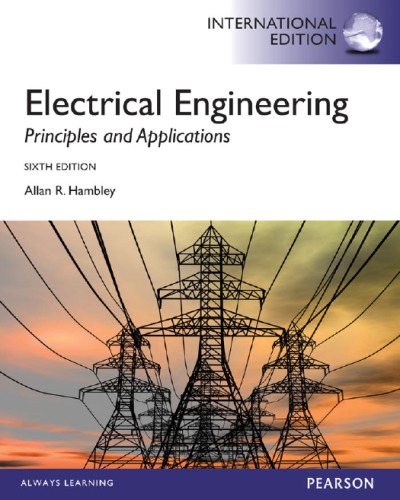

Most ebook files are in PDF format, so you can easily read them using various software such as Foxit Reader or directly on the Google Chrome browser.
Some ebook files are released by publishers in other formats such as .awz, .mobi, .epub, .fb2, etc. You may need to install specific software to read these formats on mobile/PC, such as Calibre.
Please read the tutorial at this link. https://ebooknice.com/page/post?id=faq
We offer FREE conversion to the popular formats you request; however, this may take some time. Therefore, right after payment, please email us, and we will try to provide the service as quickly as possible.
For some exceptional file formats or broken links (if any), please refrain from opening any disputes. Instead, email us first, and we will try to assist within a maximum of 6 hours.
EbookNice Team

Status:
Available5.0
36 reviews
ISBN 10: 027379325X
ISBN 13: 9780273793250
Author: Allan R Hambley
1 Introduction
1.1 Overview of Electrical Engineering
1.2 Circuits, Currents, and Voltages
1.3 Power and Energy
1.4 Kirchhoff’s Current Law
1.5 Kirchhoff’s Voltage Law
1.6 Introduction to Circuit Elements
1.7 Introduction to Circuits
Summary
Problems
2 Resistive Circuits
2.1 Resistances in Series and Parallel
2.2 Network Analysis by Using Series and Parallel Equivalents
2.3 Voltage-Divider and Current-Divider Circuits
2.4 Node-Voltage Analysis
2.5 Mesh-Current Analysis
2.6 Thévenin and Norton Equivalent Circuits
2.7 Superposition Principle
2.8 Wheatstone Bridge
Summary
Problems
3 Inductance and Capacitance
3.1 Capacitance
3.2 Capacitances in Series and Parallel
3.3 Physical Characteristics of Capacitors
3.4 Inductance
3.5 Inductances in Series and Parallel
3.6 Practical Inductors
3.7 Mutual Inductance
3.8 Symbolic Integration and Differentiation Using MATLAB
Summary
Problems
4 Transients
4.1 First-Order RC Circuits
4.2 DC Steady State
4.3 RL Circuits
4.4 RC and RL Circuits with General Sources
4.5 Second-Order Circuits
4.6 Transient Analysis Using the MATLAB Symbolic Toolbox
Summary
Problems
5 Steady-State Sinusoidal Analysis
5.1 Sinusoidal Currents and Voltages
5.2 Phasors
5.3 Complex Impedances
5.4 Circuit Analysis with Phasors and Complex Impedances
5.5 Power in AC Circuits
5.6 Thévenin and Norton Equivalent Circuits
5.7 Balanced Three-Phase Circuits
5.8 AC Analysis Using MATLAB
Summary
Problems
6 Frequency Response, Bode Plots, and Resonance
6.1 Fourier Analysis, Filters, and Transfer Functions
6.2 First-Order Lowpass Filters
6.3 Decibels, the Cascade Connection, and Logarithmic Frequency Scales
6.4 Bode Plots
6.5 First-Order Highpass Filters
6.6 Series Resonance
6.7 Parallel Resonance
6.8 Ideal and Second-Order Filters
6.9 Transfer Functions and Bode Plots with MATLAB
6.10 Digital Signal Processing
Summary
Problems
7 Logic Circuits
7.1 Basic Logic Circuit Concepts
7.2 Representation of Numerical Data in Binary Form
7.3 Combinatorial Logic Circuits
7.4 Synthesis of Logic Circuits
7.5 Minimization of Logic Circuits
7.6 Sequential Logic Circuits
Summary
Problems
8 Computers and Microcontrollers
8.1 Computer Organization
8.2 Memory Types
8.3 Digital Process Control
8.4 Programming Model for the HCS12/9S12 Family
8.5 The Instruction Set and Addressing Modes for the CPU12
8.6 Assembly-Language Programming
Summary
Problems
9 Computer-Based Instrumentation Systems
9.1 Measurement Concepts and Sensors
9.2 Signal Conditioning
9.3 Analog-to-Digital Conversion
9.4 LabVIEW
Summary
Problems
10 Diodes
10.1 Basic Diode Concepts
10.2 Load-Line Analysis of Diode Circuits
10.3 Zener-Diode Voltage-Regulator Circuits
10.4 Ideal-Diode Model
10.5 Piecewise-Linear Diode Models
10.6 Rectifier Circuits
10.7 Wave-Shaping Circuits
10.8 Linear Small-Signal Equivalent Circuits
Summary
Problems
11 Amplifiers: Specifications and External Characteristics
11.1 Basic Amplifier Concepts
11.2 Cascaded Amplifiers
11.3 Power Supplies and Efficiency
11.4 Additional Amplifier Models
11.5 Importance of Amplifier Impedances in Various Applications
11.6 Ideal Amplifiers
11.7 Frequency Response
11.8 Linear Waveform Distortion
11.9 Pulse Response
11.10 Transfer Characteristic and Nonlinear Distortion
11.11 Differential Amplifiers
11.12 Offset Voltage, Bias Current, and Offset Current
Summary
Problems
12 Field-Effect Transistors
12.1 NMOS and PMOS Transistors
12.2 Load-Line Analysis of a Simple NMOS Amplifier
12.3 Bias Circuits
12.4 Small-Signal Equivalent Circuits
12.5 Common-Source Amplifiers
12.6 Source Followers
12.7 CMOS Logic Gates
Summary
Problems
13 Bipolar Junction Transistors
13.1 Current and Voltage Relationships
13.2 Common-Emitter Characteristics
13.3 Load-Line Analysis of a Common-Emitter Amplifier
13.4 pnp Bipolar Junction Transistors
13.5 Large-Signal DC Circuit Models
13.6 Large-Signal DC Analysis of BJT Circuits
13.7 Small-Signal Equivalent Circuits
13.8 Common-Emitter Amplifiers
13.9 Emitter Followers
Summary
Problems
14 Operational Amplifiers
14.1 Ideal Operational Amplifiers
14.2 Inverting Amplifiers
14.3 Noninverting Amplifiers
14.4 Design of Simple Amplifiers
14.5 Op-Amp Imperfections in the Linear Range of Operation
14.6 Nonlinear Limitations
14.7 DC Imperfections
14.8 Differential and Instrumentation Amplifiers
14.9 Integrators and Differentiators
14.10 Active Filters
Summary
Problems
15 Magnetic Circuits and Transformers
15.1 Magnetic Fields
15.2 Magnetic Circuits
15.3 Inductance and Mutual Inductance
15.4 Magnetic Materials
15.5 Ideal Transformers
15.6 Real Transformers
Summary
Problems
16 DC Machines
16.1 Overview of Motors
16.2 Principles of DC Machines
16.3 Rotating DC Machines
16.4 Shunt-Connected and Separately Excited DC Motors
16.5 Series-Connected DC Motors
16.6 Speed Control of DC Motors
16.7 DC Generators
Summary
Problems
17 AC Machines
17.1 Three-Phase Induction Motors
17.2 Equivalent-Circuit and Performance Calculations for Induction Motors
17.3 Synchronous Machines
17.4 Single-Phase Motors
17.5 Stepper Motors and Brushless DC Motors
basic electrical engineering principles
electrical engineering principles & applications
electrical engineering principles
the electrical engineering handbook pdf
the electrical engineering handbook
quizlet electrical engineering
Tags: Allan R Hambley, Electrical, Engineering